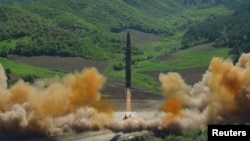In a piece published on August 1, the Russian state news agency RIA Novosti quoted Aleksei Podberezkin, director of the Center for Military and Political Studies at the Moscow State Institute of International Relations, who claimed that North Korea’s missile program does not threaten the U.S. because Pyongyang is simply unable to master military technology.
“No missile program of North Korea threatens the U.S. now. And it will be a while before it does. Theoretically, one of its missiles could reach the continental U.S. in two-three years… The DPRK does not have any unique technologies, there can’t be any… Only big states are able to develop military technologies. [North] Korea is not one of them,” Podberezkin said.
The statement is false, and follows North Korea’s two latest missile tests on July 4 and 28.
Unlike the U.S., Japan, and South Korea, Russia claims that the missiles North Korea tested were intermediate range, not intercontinental range, and thus could not reach the continental U.S.
The Washington-based Center for Strategic and International Studies, however, says that the July 4 missile launch marked North Korea’s “first-ever test of a true ICBM [intercontinental ballistic missile]” that “can deliver a warhead to a range of 5,500 kilometers or more,” potentially reaching Alaska and Hawaii.
The July 28 test yielded more concerning results. David Wright, a missile expert with the Union of Concerned Scientists, said if the missile had been launched on a standard trajectory of flight, it could have reached Los Angeles, Denver, Chicago, and possibly even New York and Boston.
Underscoring the threat posed by the country's nuclear and missile programs, on August 5, Russia joined the U.S. and China, among others, in voting for stringent UN Security Council sanctions against North Korea.
North Korea has yet to miniaturize a nuclear warhead and put it on the tip of a missile. It would also have to ensure its nuclear-tipped missile had an effective guidance system and a warhead that could re-enter the atmosphere from space intact and still hit a target.
But while North Korea might not attain the capability to strike the U.S. with a nuclear-tipped missile until at least 2018, as the Pentagon estimates, Pyongyang has clearly demonstrated the capacity to make progress in the nuclear and missile technology development cycle.
North Korea’s military is pushing ahead with testing and refining such technology using various missile delivery and launch systems, even if some, such as submarines, are outdated.
The threat of North Korea’s missile program is thus not only real, but also multi-dimensional. And it is not just North Korea’s capability to hit the continental U.S that is worrying. It is also the North Korean military’s ability to strike U.S. military and economic assets and allies in the region -- all within the range, or close to the reach, of North Korea’s missiles. Indeed, North Korea is developing missiles with different ranges and capabilities, and for different purposes.
China’s inability and/or unwillingness to convince North Korea to renounce its nuclear weapons capability and resume talks with the U.S., Russia, China, South Korea, and Japan heightens U.S. concerns that Pyongyang will eventually complete all the required technological steps to make its coupled nuclear and missile program operational.
The missile threat also stems from Pyongyang’s intentions, not just its capabilities. North Korea has on multiple occasions threatened to strike the U.S. with a nuclear-tipped ICBM if the U.S. attempts regime change or undertakes a military action against it.
U.S. defense measures, meanwhile, have fallen short. The Ground-based Midcourse Defense system, designed to provide protection against long-range missiles, has had only a mixed performance record.
At the same time, North Korea has been rushing to build a viable nuclear capability to deter the U.S. from regime change or other actions (for example, defending South Korea in case of resumed hostilities).
Podberezkin’s claim that only big states are capable of developing military technologies is also false. In fact, states of all kinds develop military technologies. This is especially true of North Korea, which is working to overcome technological constraints as it seeks to build a nuclear deterrent.
North Korea has displayed a sense of mission in this regard, particularly over the last decade, channeling major funding into its nuclear and missile programs, which the regime deems are essential for its survival given the perceived threat of U.S. military aggression.
Besides these programs, North Korea has also demonstrated the technological capacity to develop robust cyber capabilities. It has done all this despite being a small and impoverished state that has done little to improve the wellbeing of its extremely poor and malnourished population.








